5-day self-guided adventure through Northern Vietnam: Hanoi & Ninh Binh
My friend Helen & I took a trip to northern Vietnam in November 2024. It was a short visit to the capital city of Hanoi, and the nearby country town of Ninh Binh that is famous for its natural beauty. I listed all the important traveling tips, the points of interest that you must visit, and the food you need to try. As to whether Halong Bay or Ninh Binh for a day trip? That's a personal choice. As you read this blog you'll understand my reasons to go to Ninh Binh.
TRAVEL BLOG
Ting Lu
1/16/2025
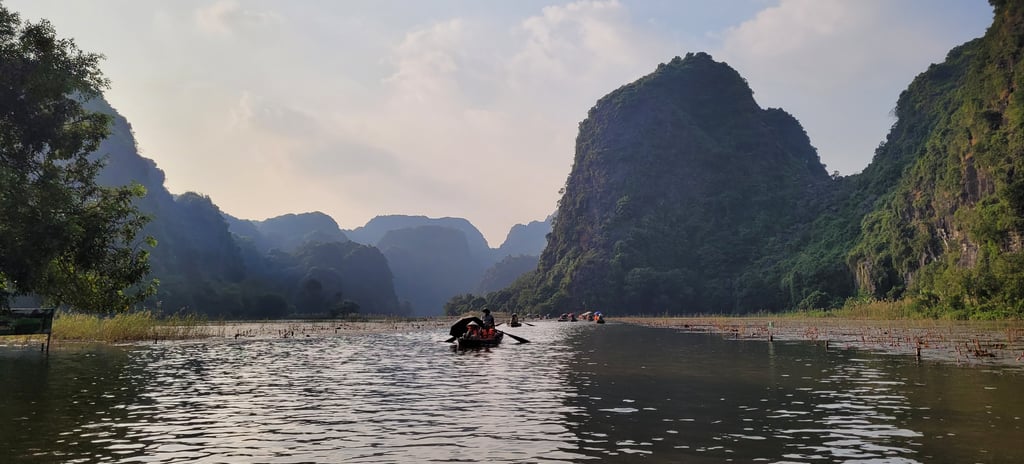

IMPORTANT TIPS:
VISA: You need to apply an E-visa online way ahead of time. It will take 3-5 business days if you didn't make any mistakes; otherwise, a week or 2. We applied 2 months early.
Luggage: Cheap airlines (such as Viet Jet) allow 2 pieces of carry-ons total 7kg per person, not a single ounce more. A check-in luggage is limited to 20kg. If you know you can't squeeze all of your belongings into a 7kg backpack, it is better to pay ahead online for a cheaper check-in. At the airport it would cost around ~$20 USD to check in a bag.
Cash: The ATMs in the Hanoi airport charge a ridiculous amount of fees - which is embedded in the amount you withdraw. Your bank will not be able to reimburse you since it is not visible. The ATMs in town might be the same. So, BRING SOME U.S. BILLS! The best place to exchange USD to VND is at the Jewelry stores. In Old Quarter Hanoi, they are many on Hang Bac street. Compare the rates with a few stores. Soon you will realize that you get better rate with larger & newer US bills ($100, $50). No need to withdraw too much Vietnamese cash. Hotels and formal restaurants take credit cards, and you can even tip with USD.
Planning ahead: With a little planning, you can travel independently and inexpensively in Vietnam. Booking.com has many great hotel deals. You can contact your hotel ahead of time to arrange local travels (such as from Hanoi to Halong Bay or Ninh Binh). We spent less than $300 USD per person total for all 5 days, that includes transportation, lodging, food, tickets, shopping, and a full day tour of Ninh Binh!
Day 1: Arrival in Hanoi
Lodging Hanoi city center is about 45min - 1 hour from the airport. Due to our late arrival, I made a reservation in "Airport Classic Hotel & Travel" thru booking.com. $32 one night for 2 including breakfasts. It is about 5 minutes taxi ride, nothing fancy or terrible, just adequate. My breakfast was a bowl of Bun Cha (however, too sweet, and sour, and cold.)
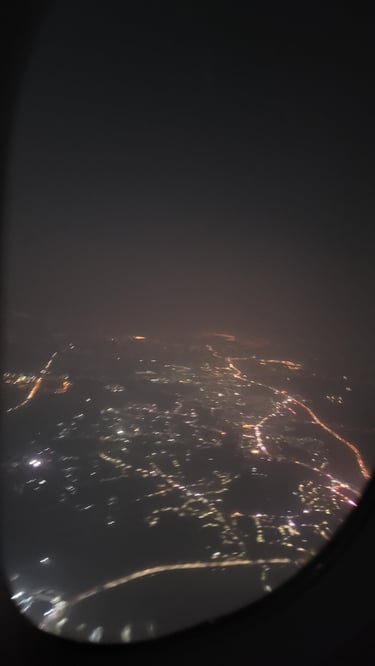
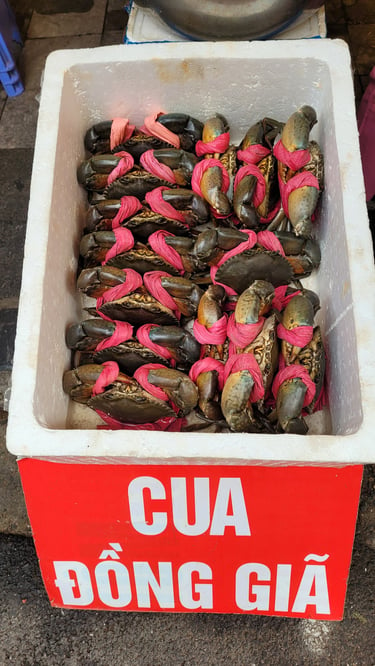
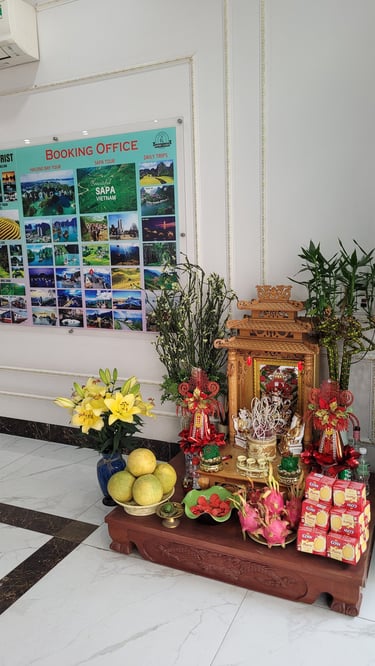
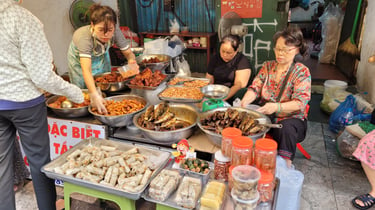

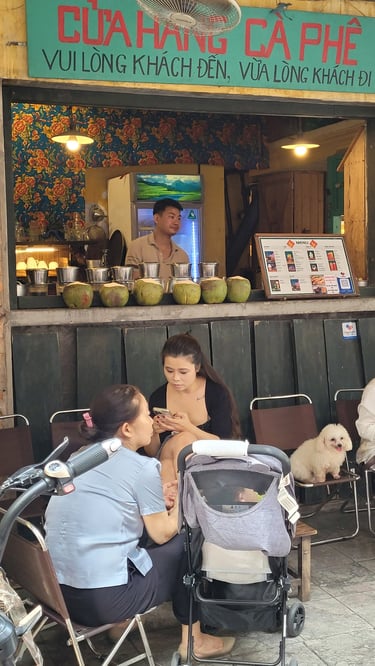
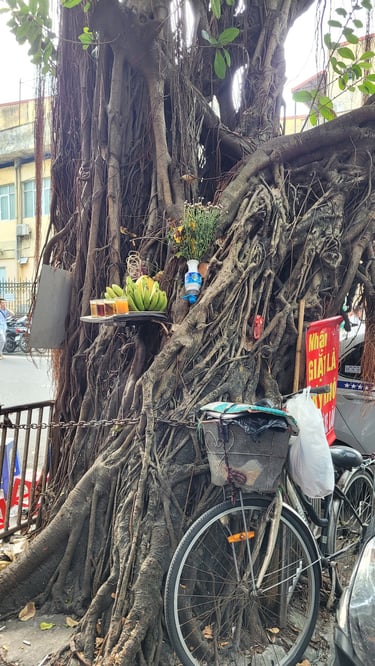
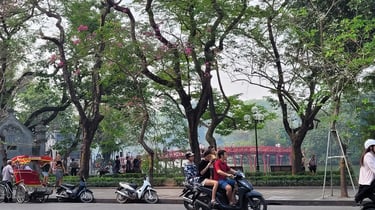








Day 2: Hanoi Old Quarter
Lodging When selecting accommodations in Hanoi, the Old Quarter is a highly recommended area. There is a myriad of lodging options, ranging from luxurious hotels to budget-friendly hostels. Staying in this area allows us to immerse in the local food, traffic, shops, and culture from the moment we arrive. We booked "Ha Noi Lakeview Hotel & Travel" in booking.com, with total cost of $3,888,000 VND (~$156 USD) for 4 nights, 2 people, and breakfast included. It is a narrow 7-floor building with a small elevator, and 2 additional floors with uneven steps to go up to the rooftop for the breakfast buffet.
Our 2nd-floor room is right next to an atrium in the center of the building. One night when we came back, the room was filled with cigarette smoke. We complained to the front desk and immediately someone with an air freshener machine showed up to clean the air. We guess one of the hotel workers just smoked in the atrium. Not surprising, almost every Vietnamese man smokes! The next day they moved us to the 5th floor.
Transportation Airport Classic Hotel arranged a private car to take us to the Hanoi Lakeview Hotel in Old Quarter for 250,000 VND (~$10 USD). It's a 45-minute ride from the airport to Hanoi town center, highway for the most part. In Hanoi, we walked almost everywhere, that's over 20000 steps a day. Twice we called a rickshaw, but never a taxi, or a motorbike.
Hanoi Old Quarter As the city’s business hub and main tourist destination, Hanoi Old Quarter offers the French-colonial architecture, rich food culture, and a long history. In the past, all the tradesmen of a single craft would gather together in one street and many of the Old Quarter’s streets were dedicated to a single trade or guild. This practice has survived over the years and it can be fun to walk down each street to see what wares are sold there. While having a stroll around the Old Quarter, you’ll spot temples, gates, and halls dating back centuries.
Later I learned that two sights that show wildly different sides of Hanoi are the grey, Gothic Saint Joseph Cathedral and the well-preserved, traditional Ancient House. I think we passed the buildings without paying any attention.
Hoa Lo Prison Originally named Maison Centrale, the prison was built by the French in 1896, on the site of what is now Hanoi’s downtown section. Most of the prisons have been demolished to build modern high-rises, only a quarter of the original prison remains as a museum. Among the items on display are various instruments of torture, including whips, shackles, and a guillotine. Also preserved in their original condition are the French-period solitary confinement cells and the narrow tunnel through which more than a hundred Vietnamese prisoners escaped to freedom in August 1945. However, most of the communist party members were tortured to death. The whole place is cold, dark, and gruesome.
In the early 1970s, Hua Lo prison was used again during the Vietnam war for North Vietnamese to imprison South Vietnamese and its ally soldiers (e.g., John McCain). For this time period it is presented in a totally different light - where the captured US soldiers were treated with "comfort & dignity", hence the prison is nicknamed "Hanoi Hilton". Many pictures only show the foreign prisoners laughing, singing, playing basketballs, guitars, & card games. Propaganda, you may say?
Women’s Museum The Vietnam Women’s Museum is a place pays tribute to the women of Vietnam across the ages. There are plenty of historical contexts alongside a wealth of information on today’s more modern Vietnamese woman. Inside the museum is supposed to be a lots of narrative as women of the rice paddy fields, service workers, street vendors, female business leaders, academics and mothers, including their marriage, family life, fashion and life changing rituals, and their participation in the Vietnam war. We looked at the paintings, sculptures, and the handcrafted souvenirs in the lobby, but didn't purchase tickets to go into the museum, thinking likely just another exhibit of propaganda, maybe?
Hanoi Opera House Built in 1911, the Hanoi Opera House is the biggest theatre in Vietnam and as a historical and cultural evidence of Vietnam under French rule. It’s a piece of neo-classical French architecture featuring Gothic themes on the doors and domes with pillars, shuttered windows, balconies and a glass room. The interior is supposed to be even more magnificent than the exterior, with aesthetics comparable to the Paris Opera House. Well it was closed for visiting. So I have no proof to such a comparison.
After the Hanoi Opera House, we decided to take a Rickshaw back to the hotel. It wasn't a long ride, but rush-hour streets are packed with scooters, bicycles, and cars swarming around like a school of fish. We have no choice but to face the exhilarating traffic.
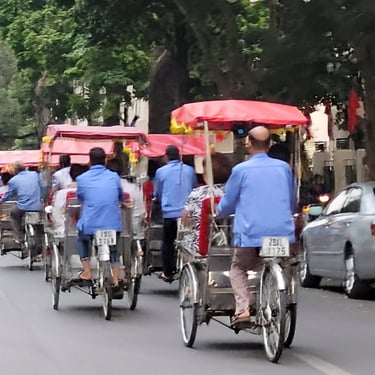
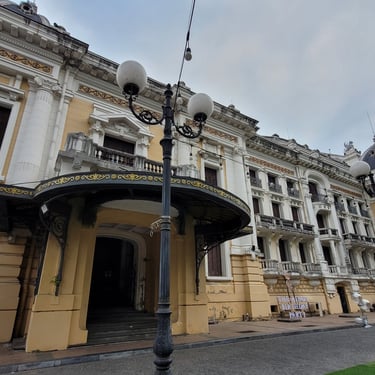
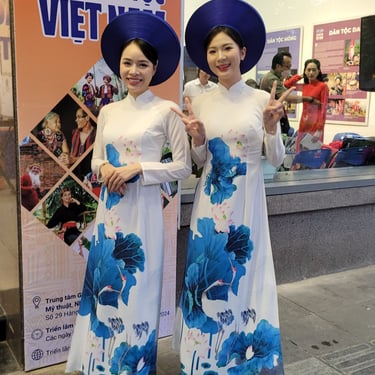

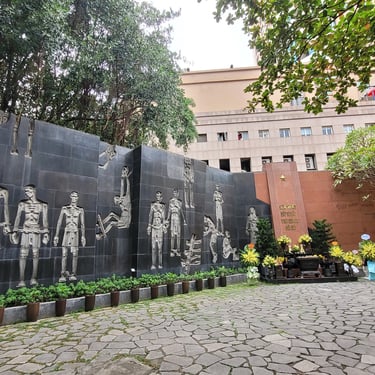
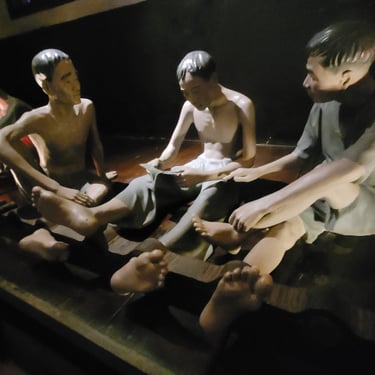
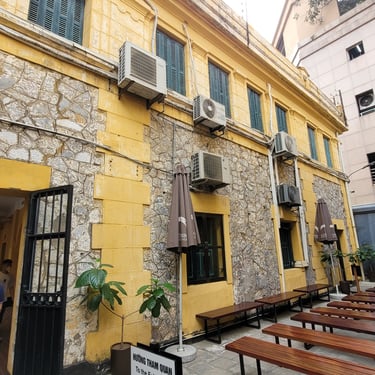
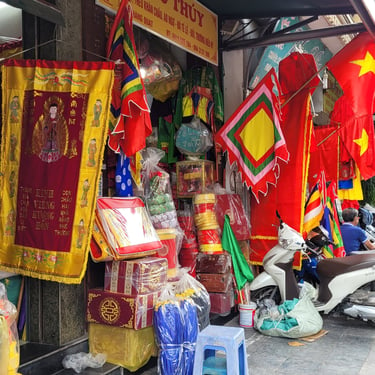
Day 3: Exploring Historical Landmarks
The Train Street One of the most curious and picturesque spots in Hanoi is the “train street”. In the Old Quarter train tracks squeeze through some of the city’s more narrow streets, with the doors of people’s homes opening out onto them. Twice a day a large train makes its way through this residential area, with residents squeezing into doorways to keep clear. Today it is a tourist attraction jampacked with vendors all around the track. We waited at a food stall until 11:45am, when the train was finally honking & moving slowly thru the street, barely touching the onlookers' clothes.
Temple of Literature, which is Vietnam's first national university. Established in 1070, this complex is dedicated to Confucius and represents an important milestone in promoting education and culture in Vietnam. As we stroll through its tranquil gardens, we can see the strong Chinese influence reflected on this institution in shaping Vietnam’s intellectual heritage.
Ho Chi Minh Mausoleum is a significant site dedicated to the leader of Communist Vietnam. Situated in Ba Dinh Square, this imposing structure is not just a resting place but also a symbol of national pride and heritage for the North Vietnamese. We paid entrance fees and then walked along a pathway in parallel to the Mausoleum, eye-witnessed the local soldiers bowing and crying to pay tributes to their beloved leader who died 45 years ago. However, the Mausoleum wasn't open for public viewing of Ho's embalmed body today.
Imperial Citadel of Thang Long Thang Long Citadel is a monument of Vietnamese history and was recognized by UNESCO as a World Heritage Site in 2010. Also known as Hanoi Old Citadel, many antiques and items are from the middle. The 6th and 20th centuries were excavated in 2004, including the foundations of old castles, ancient roads, ponds, and wells. Again, we didn't pay entrance fee to go inside, rather, I was more intrigued by the pickleball playing in front of the citadel building. I went up to the young men asking to join for a game, but they responded with confused and skeptical looks.
Water puppet show The 2nd day was concluded with the enchanting 6:30pm show at the Thang Long water puppet theater. It is a traditional Vietnamese art form that dates back to the 11th century. Performed on water, this unique show features intricately crafted puppets that dance and tell stories from Vietnamese folklore. The performance originates from the time when the rice fields were flooded and the villagers would entertain by standing underwater to the waist with puppets performing on the water. Now in the theatre, it appears as if the puppets are moving on the water while the puppeteers, hidden behind a screen, are manipulating the puppets with long supporting bamboo sticks. The show was accompanied by a Vietnamese orchestra playing traditional music using drums, wooden bells, horns, bamboo flutes, and cymbals. There are also authentic Vietnamese songs that tell the stories. What a unique experience!
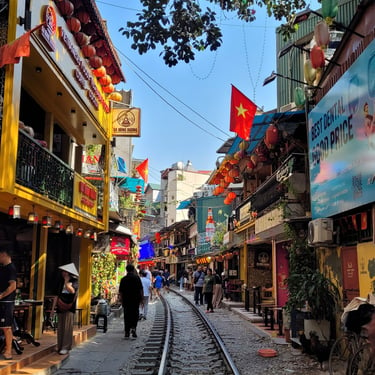
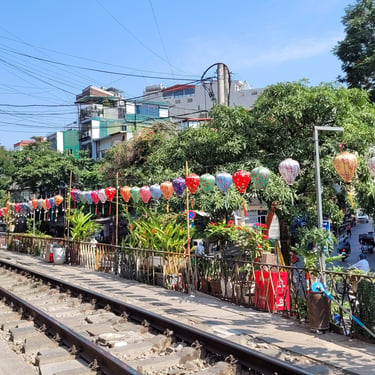
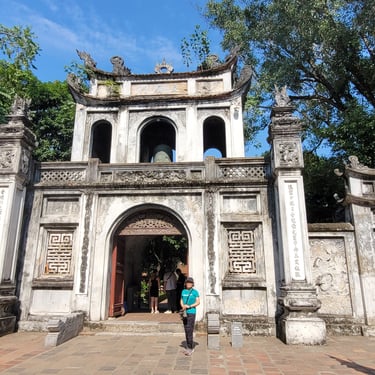
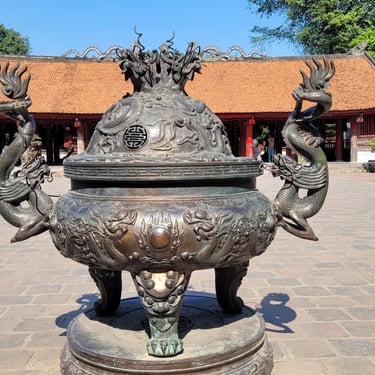
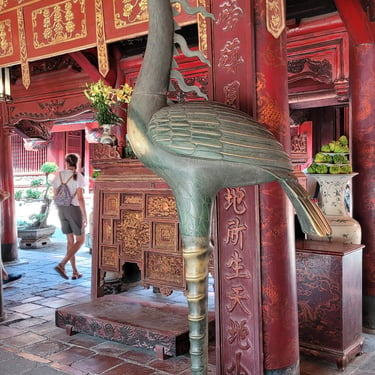
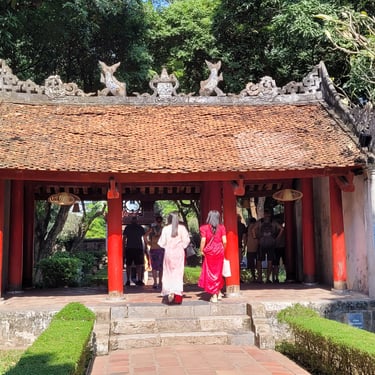
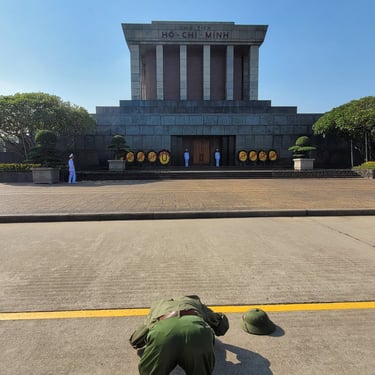
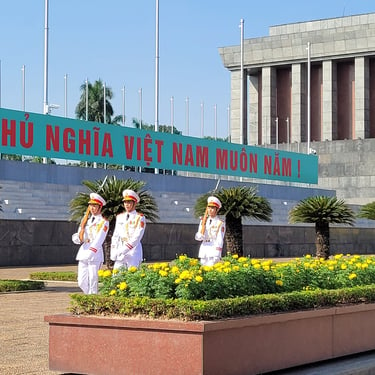
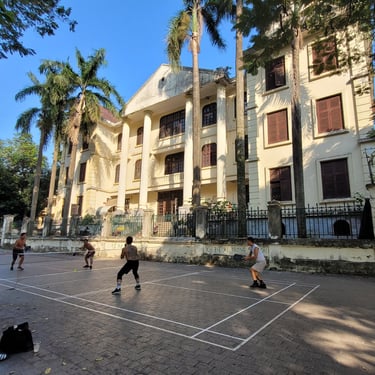
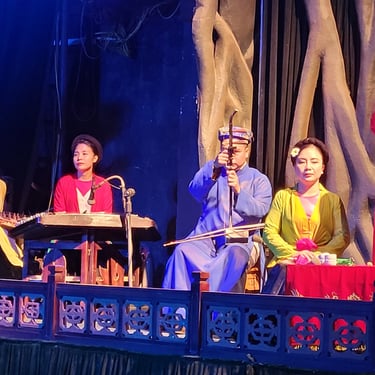
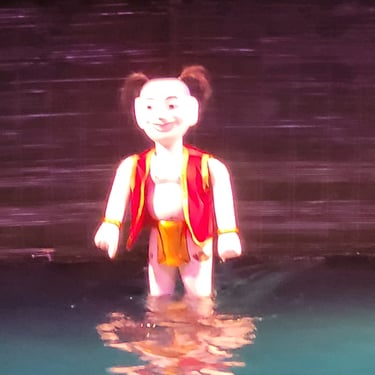
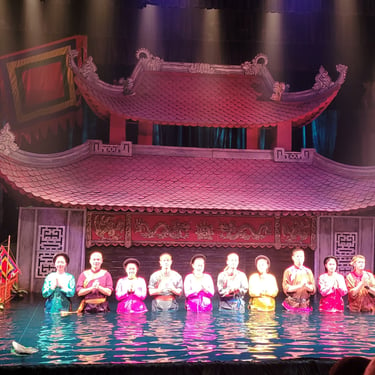
Day 4: Journey to Ninh Binh
Halong Bay or Ninh Binh? I had been debating which place is better for a day trip way before I arrived Hanoi. Halong, by the coast, is by far the most famous tourist attraction in Vietnam. It is extremely crowded, with filthy water as shown in many youtube videos. Although it is do-able for a day trip to Halong from Hanoi (~3 hours each way), it is much preferred to stay 2-3 days onboard a cruise ship. Meanwhile Ninh Binh is called "Halong Bay on Land" with similar scenery but a lot less tourists. It is also closer to Hanoi so a day-trip is more manageable. Due to the time constraint and my rational fear of crowds, ... Ninh Binh, it is!
The journey from Hanoi to Ninh Binh presents an excellent opportunity to see Vietnam's captivating natural beauty. Our trip was arranged ahead of time by the hotel (via Whatsapp). It provides a tour guide, a driver, and a 17-seat mid-size bus. Picked up by the hotel at 7:30am, the tour took about 12 hours, with two-hour drive each way. The cost is $50 USD per person, including transportation, entrance fees, buffet lunch, and bottles of water.
The first stop was Mua Caves (Mua means Dance). I opted for a very challenging hike up to the Ngoa Long mountain top. It was 550 steps of uneven rock stairs carved on the side of the mountains. The top viewpoints yield unparalleled vistas of the lotus paddies and dramatic karst hills that define the landscape. You can have a broad view of Ninh Binh city on one side, and the Ngo Dong river on the other. The climb was very tough, yet the panoramic views from the top are undeniably rewarding. In the end, Helen was very impressed by my round-trip ascend/descend in 40 minutes.
Next we explored the intriguing historical temple at the ancient capital of Hoa Lu during the Dinh and Le dynasties. Most people chose to go the temple on a bike, but Helen and I stayed on the bus to avoid any unnecessary injury. The cyclists can traverse the winding paths to observe agriculture in action, particularly rice cultivation which is prevalent in these regions.
If you can stay in Ninh Binh for a few days, I highly recommend to rent a bike to wander through the rural countryside. It provides an opportunity to encounter Ninh Binh’s charming villages and witness the daily lives of the locals.
Lastly we were at the picturesque Tam Coc caves. A visit to Tam Coc is indispensable, which provides serene 1.5 hour boat ride through picturesque waterways surrounded by towering limestone karsts. This unique topography has earned Ninh Binh the nickname "Halong Bay on land," as its intricate network of rivers and natural rock formations creates a marvel that can easily captivate visitors. During these boat excursions, we appreciate the lush greenery even more. It creates a tranquil atmosphere perfectly for relaxation and exploration.
Ninh Binh’s ecosystem is a major draw for nature enthusiasts. Wildlife sightings are possible, including various bird species and native fauna, particularly in the wetlands around the area. As one wanders through rice fields and along riverbanks, the rich biodiversity of Ninh Binh becomes apparent, providing insight into the environmental significance of these natural habitats. Engaging with the scenery and the unique ecosystems enhances the overall experience, making it a key component of any visit to Ninh Binh.
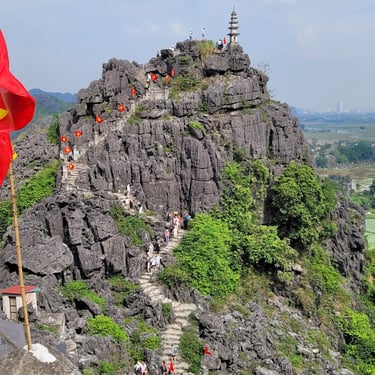
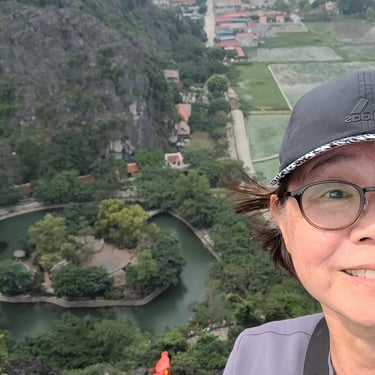
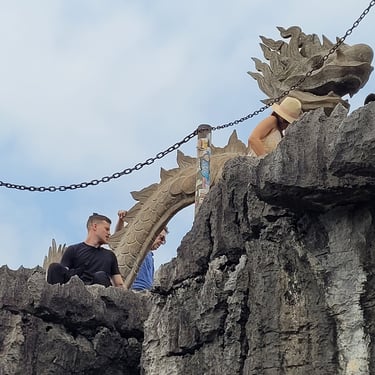
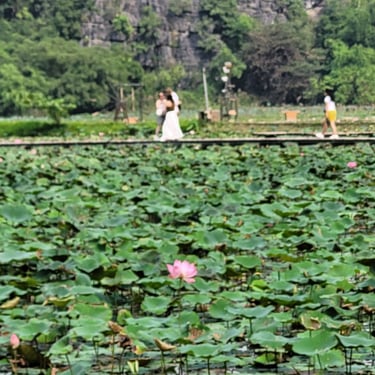
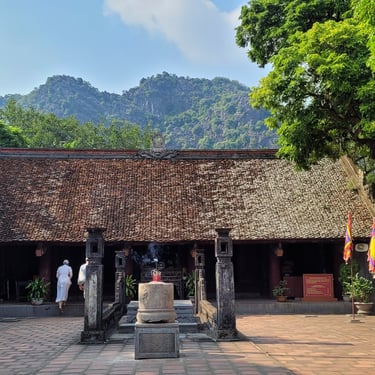
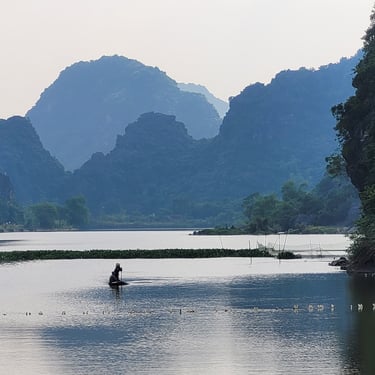
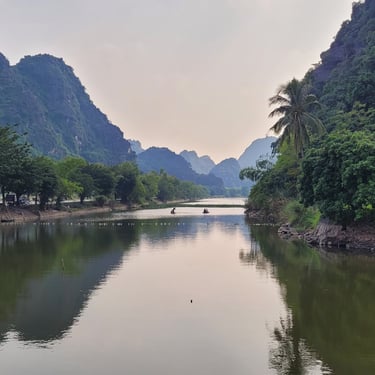
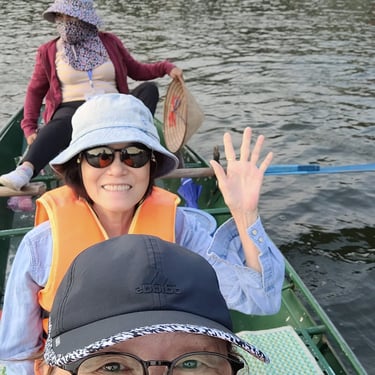
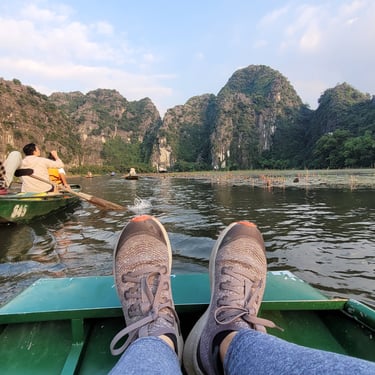
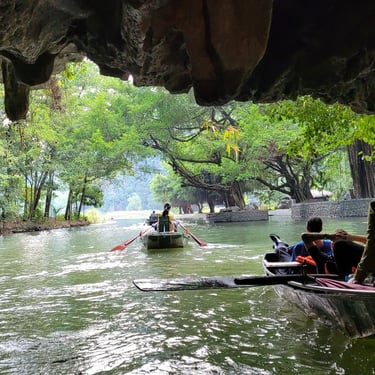
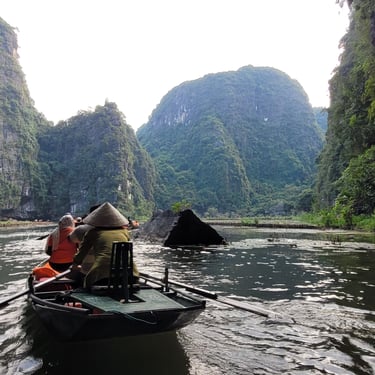
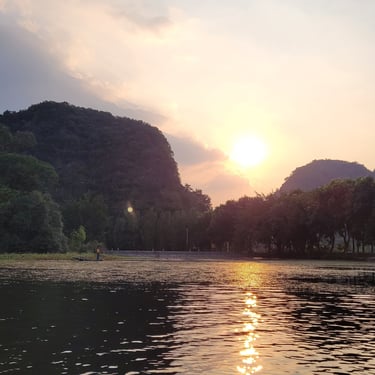
Day 5: Shopping & leisure experiences
The last day in Hanoi is a day of leisure. Although the hotel we stayed is right next to the famous Koan Kiem Lake, we passed by several times, but haven't purposely visited the lake and Ngoc Son Temple.
Hoan Kiem Lake & Ngoc Son Temple As one of the landmarks of Hanoi, Hoan Kiem Lake impresses tourists by tranquility and peacefulness, privately away from the bustling urban life. This is the only lake in Vietnam that is home to an iconic tortoise, that has a preserved specimen of a giant turtle weighing 250kg in Ngoc Son Temple. The temple was built to commemorate the 13th-century military leader Tran Hung Dao, famous for his bravery in the battle against the Nguyen dynasty. The lake and the temple are probably the most iconic places in the city of Hanoi.
Dong Xuan Market Established in 1889, Dong Xuan Market is housed within a four-story Soviet-style building on the northern edge of Hanoi Old Quarter. It’s also known as Hanoi’s largest indoor market, offering a wide range of goods such as produce, souvenirs, accessories, and clothing, mostly for wholesale. We wandered the building and came out empty handed. At the hotel we saw a few Russian ladies who bought a ton of clothes, likely from Dong Xuan, are packaging them into suitcases to be weighted on the scale provided by the hotel.
Surrounding Dong Xuan Market are many more shops where you can purchase cheap clothes, counterfeit sportswear, handbags, & accessories. I bought two "Nike" shorts, each under 100,000 VSD (~$4 USD).
Massage We tried 2 different massage parlors in the Old Quarter, but were disappointed by their skills. Young women apparently with little training are the main workforce in these parlors. The price is cheap, and they do demand tips after the mediocre service. So think twice before you walk into one of these inexpensive parlors without other's recommendations.
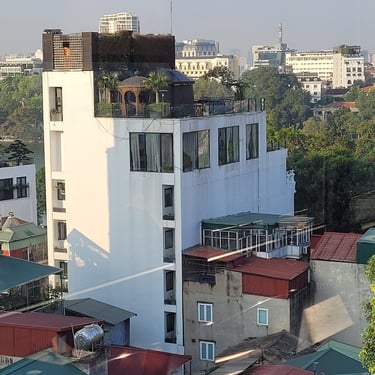
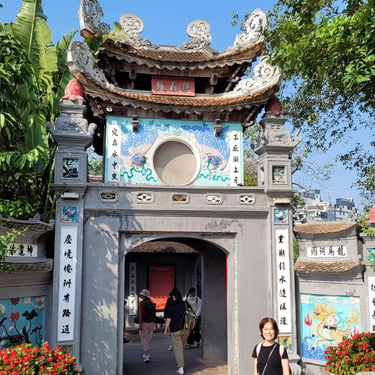
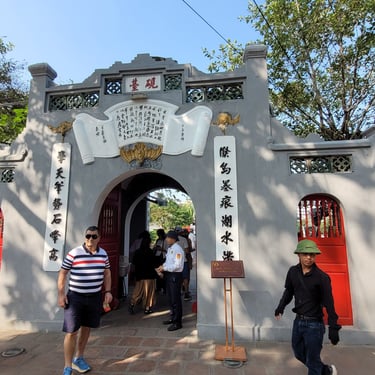
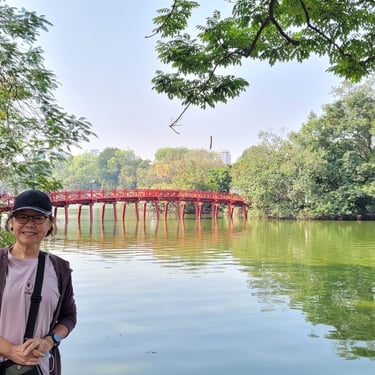
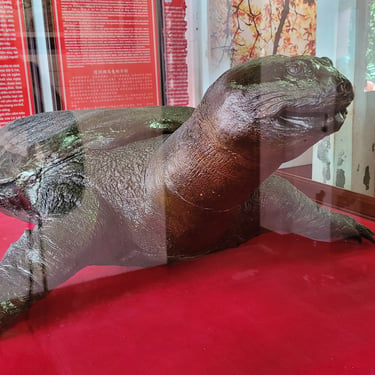
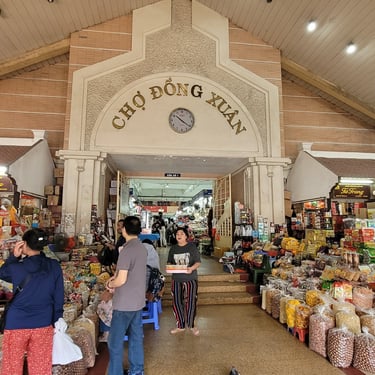
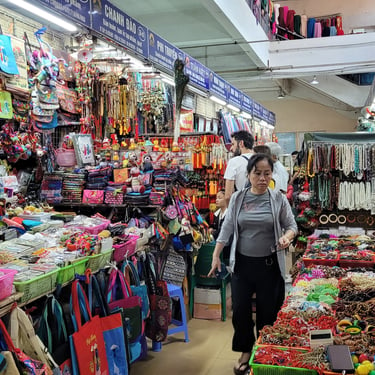
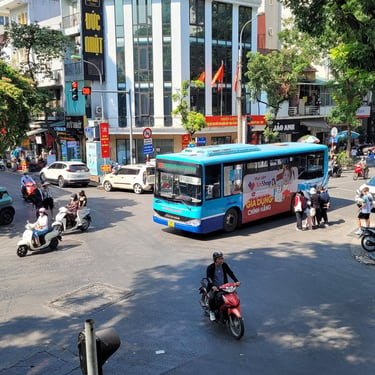
Day 6: Departure
The hotel called a private taxi for us to go to the airport for 200,000 VND (~$USD). It was 50,000 VND less than our first day ride into town. Before leaving the hotel, we borrowed the scale to weigh our bags to ensure that all are within the airlines guideline:
personal carry-on total < 7kg,
check-in luggage < 20 kg.
The food we tried:
No visit to Hanoi would be complete without indulging in its culinary delights. Traditional Vietnamese dishes are abundant. Some must-try dishes include "pho," a hearty noodle soup typically enjoyed for breakfast, and "bun cha," a flavorful dish of grilled meat served with vermicelli noodles. Don't forget to sample "banh mi," a delicious Vietnamese sandwich that epitomizes the country's colonial influences. I highly recommend the following places for you to try something exotic but delicious.
Seafood Noodle Soups/Wonton Soups
43 Cau Go
For 50,000 VND (~$2 USD) it is the most inexpensive, nutritious, & delicious street food we had in Hanoi.
Mien luon Dong Thinh (炸鳗鱼/冬粉汤)
Address: 87 Hang Dieu, Hoan Kiem, Hanoi
This restaurant is known for being one of the best places in Hanoi to have Luon (eel). Unlike Japanese unagi where the eel is grilled, most eel in Vietnam is dried then deep-fried so it’s crispy like dried anchovies. They were very crunchy but still had that signature sweetness. The eel was served with glass noodles (Mien) or Congee, fried garlic and shallots, optionally with cucumber slices, chopped peanuts, and fresh herbs and greens, with just a shallow layer of broth made from eel bones and ginger.
Pho
Pho is arguably Vietnam’s most iconic dish. It’s a Vietnamese noodle soup made with four ingredients – clear stock, rice noodles, meat (beef or chicken), and a few herbs. From humble sidewalk stalls to upscale restaurants, you can find it everywhere in Hanoi. Cherry, the travel guide in the hotel recommended a small Pho shop nearby (sorry, I forgot its name). 60,000 VND (~$2.5 USD) for a bowl of the beef pho.
For your reference, the Pho in the US the Vietnamese restaurants are mostly southern style, with bean sprouts and a wider variety of fresh herbs (Lemongrass, Basil, Chilis, etc). The broth in southern Pho is typically sweeter and with narrower noodles as well.
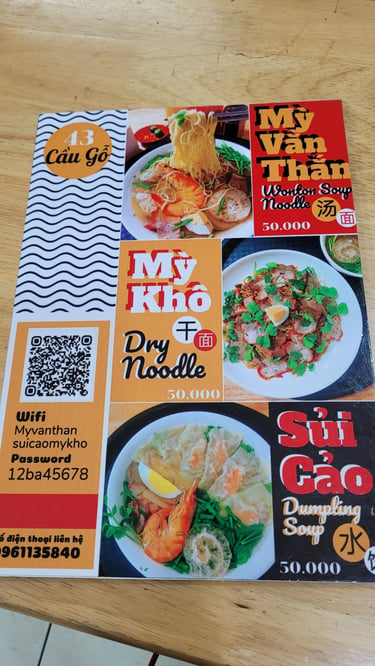


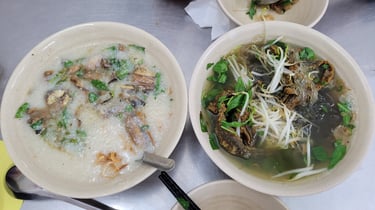
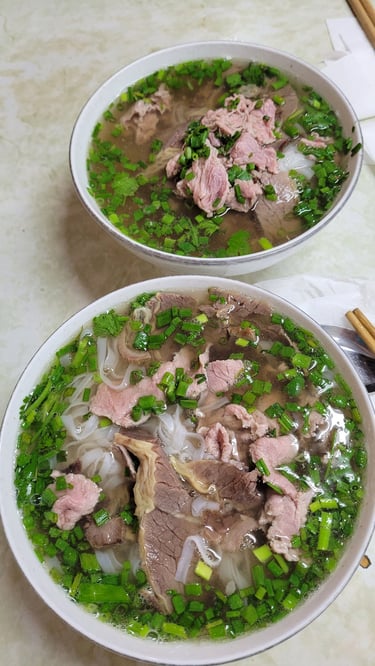





Custom order? Questions?
Please contact me
ms.ting.lu@gmail.com
678-404-8084
In-person Classes & Workshops held in Ting Lu Design Studio in Alpharetta, GA 30022
